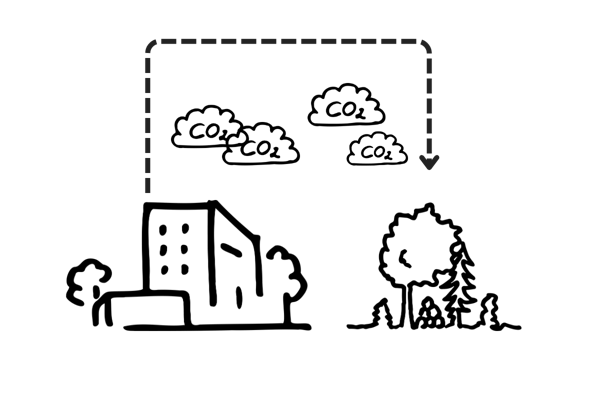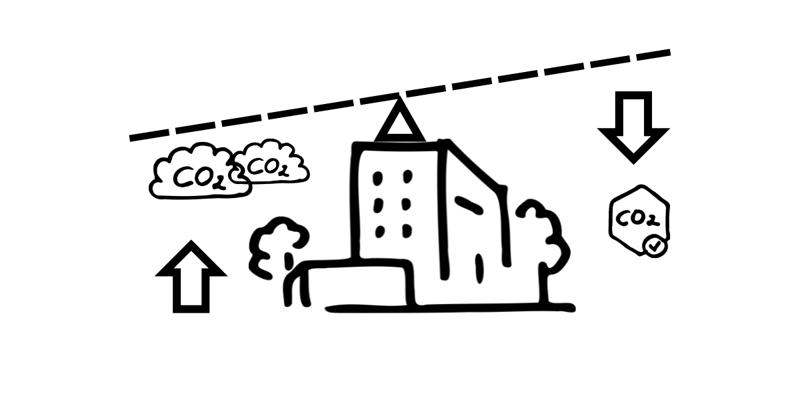
Navigating Decarbonization: How Companies Can Address Emissions
Navigating Decarbonization: How Companies Can Address Emissions Inside and Outside Their Value Chains
With the upcoming Corporate Sustainability Reporting Directive (CSRD) and the undeniable consequences of the current climate crisis, more and more companies must address the emissions associated with their operations. For companies already subject to the CSRD, it will be crucial not only to transparently report their emissions but also to include their Scope 3 suppliers’ emissions. Therefore, it is essential to not only monitor a company’s emissions but also to define a clear decarbonization strategy.
A corporate decarbonization strategy (or sustainability strategy) is utilized to accelerate the reduction or removal of carbon emissions and other Greenhouse Gas Emissions (GHG emissions) within or outside a company's value chain.
Classification of Greenhouse Gas Emissions by Companies
To select and implement a decarbonization strategy, emissions must first be monitored. The Greenhouse Gas Protocol (GHG Protocol) helps companies better understand and manage their carbon footprint by introducing a classification system to categorize emissions in three scopes:

Scope 1: Direct Emissions
Emissions from sources directly controlled or owned by the company:
- Company facilities
- Company vehicles
- Onsite material processing
- Etc.
Scope 2: Indirect Emissions
Emissions from the generation of purchased energy consumed by the company:
- Purchased electricity
- Heating
- Cooling
- Etc.
Scope 3: Other Indirect Emissions
Emissions from the company’s value chain, both upstream and downstream:
Upstream:
- Purchased goods and services
- Transportation and distribution
- Business travel
- Employee commuting
Downstream:
- Transportation and distribution
- Use of sold products
- End-of-life treatment of sold products
- Etc.
Different Approaches after Reduction
At its core, decarbonization focuses on taking direct actions to address and reduce emissions at their source. Companies implementing a decarbonization strategy typically begin by collecting detailed data on all aspects of their operations that contribute to carbon emissions. This is followed by comprehensive emission accounting across all scopes, particularly Scope 3, which often holds the largest potential for reductions and avoidances.
A decarbonization strategy is a holistic approach that impacts every operational facet of a business—from energy use to manufacturing, supply chain logistics, and product design. It requires innovation and a strong commitment to sustainability across all business operations.
Many companies use the mitigation hierarchy as a framework for their decarbonization strategy and to achieve their climate targets. After avoiding and reducing emissions, companies often still face hard-to-abate emissions. To address these, Carbon Insetting and Carbon Offsetting can be effective solutions.
Insetting
Carbon insetting is a decarbonization approach where companies focus on reducing emissions within their own supply chains and operations. This strategy involves implementing projects that are directly related to the company’s value chain, often utilizing Nature-based Solutions (NbS) such as Improved Forest Management (IFM), regenerative agriculture and ecosystem restoration. Insetting not only aims to lower carbon emissions but also delivers additional benefits, including improved supply chain resilience and support for local communities. It is particularly effective for addressing Scope 3 emissions, which are often the most challenging to mitigate.
- Impact Area: Internally within a company‘s value chain (mostly Scope 3 emissions)
- Approach: Long-term, integrated approach
- Benefits: Supply chain resilience, enhanced sustainability, broader social responsibility, improved relationships with suppliers

Insetting integrates sustainability directly into a company’s core operations, creating long-term environmental and social impacts while enhancing overall business performance.
Offsetting
Carbon offsetting is a decarbonization approach where companies compensate for their hard-to-abate emissions by investing in climate projects that avoid, reduce or remove greenhouse gases elsewhere. Key aspects of carbon offsetting include purchasing Carbon Credits from projects that reduce, avoid, or sequester emissions, such as reforestation efforts, or methane capture initiatives. These projects are typically located outside of the company's direct operations or supply chain.
While offsetting can help companies achieve carbon neutrality goals, it's generally considered a complementary strategy to be used after implementing direct emission reduction measures.
- Impact Area: External to the company‘s value chain
- Approach: Short-term, ideally complementary to reductions
- Benefits: Immediate results, Carbon neutrality or compensation for emissions

When carbon offsetting is used responsibly as part of a comprehensive decarbonization strategy, it can play a valuable role in addressing hard-to-abate emissions and supporting global climate action.
Conclusion:
Both insetting and offsetting can be part of a comprehensive decarbonization strategy, but they serve different purposes and have distinct implications for sustainability and corporate responsibility.
„To view the need of the hour with an objective lens, there needs not be a trade-off between the two – offsetting and insetting.
While an important tool, offsetting cannot be considered as a substitute for direct emissions reductions by corporates (for which insetting is instrumental). Inferring from the companies making tangible progress with their insetting activities, the world would be better poised to achieve the climate goal of 1.5°C if companies adopted both routes.“
Source: World Economic Forum
Sabine Schneider
Senior Content Marketing Manager I Forest Green Communications
A lifelong forest lover, working in climate action since 2021.
